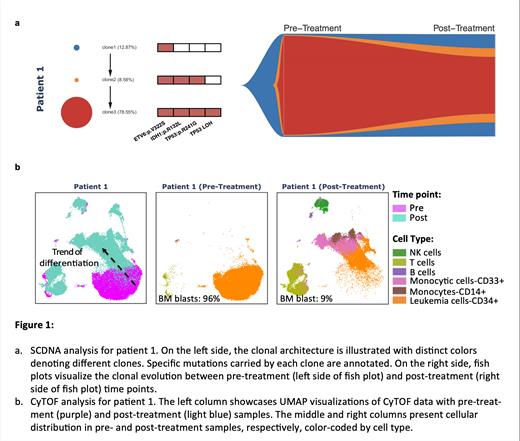Introduction:
Acute myeloid leukemia (AML) is a heterogeneous disease characterized by accumulation of abnormal hematopoietic stem and progenitor cells. TP53 mutations, present in 8 - 30 % of AML, are associated with high risk of relapse and poor prognosis. The mechanisms underlying their persistence are not well understood. Here, we attempt to describe the clonal architecture and immunophenotypes of TP53 mutant ( TP53-mut) clones during therapy. Leveraging advancements in single-cell sequencing and machine learning models, this study integrated single-cell mass cytometry (CyTOF) and single-cell DNA + protein sequencing (seq) profiling of ten paired pre- and post-treatment samples from five TP53-mut AML patients.
Methods:
Patients 1 and 3 received treatment with CD47AB (Magrolimab), 5'-Azacitidine (Aza), and Venetoclax (Ven); Patient 2 received IMGN632 (CD123-targeting ADC), Aza and Ven. Patient 4 received p97 Inhibitor CB-5339; Patient 5 received CD47 inhibitor (ALX148), Aza, Ven. Consequently, Ven/Aza served as the therapeutic backbone for most patients.
For single cell DNA+protein analysis, we sequenced a total of 44,550 cells from these 10 samples. Samples with at least 70% viability were stained with the Total-Seq™-D Human Heme Oncology Cocktail, containing 45 oligo-conjugated antibodies for surface markers relevant to AML. For mutation analysis, we utilized a validated AML custom panel (Morita et al. 2020) covering recurrent mutations in 37 genes. For CyTOF, we multiplexed samples and stained with 50 antibodies characterizing lineage, apoptosis, and signaling pathways. We successfully constructed a machine learning model for integrating both data types using our gradient boosting algorithm established pipelines and were able to predict DNA mutation status in CyTOF data with over 95% accuracy.
Results:
Analysis of the clonal architecture revealed the presence of TP53 mutations not only in AML blasts but also in lymphocyte subpopulations in all TP53-mut clones from the patients in this study. For example, in patient 1, as a representative case, TP53 mutations were observed in 16.5% of CD4+ T cells, 35.9% of CD8+ T cells, and 19.2% of NK cells.
Clonal evolution analysis showed sensitivity of TP53-mut clones with TP53 Loss of heterozygosity ( TP53 mut + LOH) to Ven/Aza and monocytic differentiation in resistant cells, potentially a manifestation of their stem-like nature. Patient 1 displayed three distinct subclones: clone 1 harbored an ETV6 mutation (p.V322S), clone 2, derived from clone 1, acquired additional IDH1 (p.R132L) and TP53 (p.R241G) mutations, clone 3, originating from clone 2 and comprising the highest proportion, exhibited loss of the other TP53 allele (LOH), and decreased from 96.2% to 55.2% post-treatment (Figure 1A). Meanwhile, clone 1 and clone 2 increased from 1.9% to 27.3% and 1.9% to 17.4% respectively.
Dissecting the phenotypic changes, clone 3 showed significant pre- and post-treatment shifts in cellular composition. Pre-treatment, it consisted predominantly of 89.7% CD34+ blasts and only 0.2% CD16+ monocytic cells. Post-treatment, CD34+ blasts decreased to 9.3%, while CD16+ monocytic cells increased to 67.8%. CyTOF analysis corroborated our findings (Figure 1B) with trajectory analysis revealing that AML cells had a stemness profile (CD34+CD38- and C-kit+) located at the beginning of the trajectory. Conversely, post-treatment AML cells displayed a loss of stemness and expressed myeloid differentiation markers, including CD33, CD11b, CD14, and CD68. We concluded that Ven-based treatments induce monocytic differentiation in resistant AML cells.
CyTOF analysis of the proteomic profiles of resistant cells revealed an increase in Ki67, BCL-XL, and 4EBP1 and a decrease in CD34 and C-KIT, suggesting a potential resistance mechanism involving the upregulation of anti-apoptotic molecules and mTOR pathway. Notably, CD36, a fatty acid transporter, exhibited increased expression in monocytic cells, suggesting an altered metabolism in the survival monocytic cells.
Conclusion:
This study establishes a genotype-phenotype connection through single-cell proteogenomic profiling of TP53-mutated AML, describing the clonal evolution and immunophenotypic dynamics during treatment while proposing a potential mechanism of resistance.
Disclosures
Nishida:Kintor Pharmaceutical: Research Funding. Haferlach:MLL Munich Leukemia Laboratory: Current Employment, Other: Equity Ownership. Issa:Merck: Research Funding; NuProbe: Consultancy; Novartis: Consultancy, Research Funding; Syndax: Research Funding; Celgene: Research Funding; Kura Oncology: Consultancy, Research Funding. Andreeff:Kintor Pharmaceutical: Research Funding; PMV: Research Funding.


